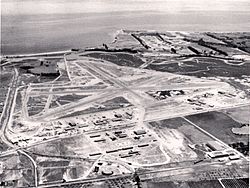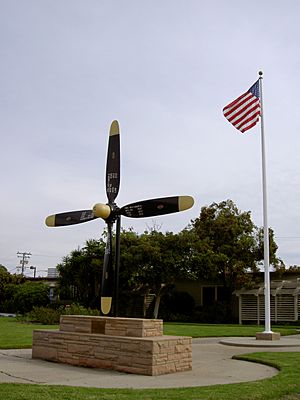Marine Corps Air Station Santa Barbara facts for kids
Quick facts for kids
MCAS Santa Barbara
Goleta Field
|
|||||||||||
|---|---|---|---|---|---|---|---|---|---|---|---|

Overhead MCAS Santa Barbara in April 1944
|
|||||||||||
| Summary | |||||||||||
| Airport type | Military | ||||||||||
| Location | Santa Barbara, California | ||||||||||
| Coordinates | 34°25′34″N 119°50′25″W / 34.42611°N 119.84028°W | ||||||||||
| Runway | |||||||||||
|
|||||||||||
Marine Corps Air Station Santa Barbara (MCAS Santa Barbara) was a special air base for the United States Marine Corps. It was located in Goleta, California, about 70 miles (113 km) north of Los Angeles. This base was very important during World War II. It was also known as the Goleta Air Station back in the 1940s.
The air station officially opened on December 4, 1942. It had an airfield built on land that used to be part of the Goleta Slough (a marshy area). MCAS Santa Barbara was a training base for many Marine squadrons. These squadrons would then go on to fight in the Pacific Theater. Later in the war, the base trained Marines to fly planes from aircraft carriers. These planes helped support other Marines fighting on the ground.
After Japan surrendered and the war ended, the air station closed in 1946. Today, the land where it once stood is home to the Santa Barbara Municipal Airport and the University of California, Santa Barbara campus.
Contents
History of the Air Station
How the Airfield Started
In the early 1930s, an airfield and a flight school were built in Goleta, California. This place later became the Santa Barbara Municipal Airport. In 1940, a government group called the Civil Aeronautics Authority suggested making the airfield bigger. This was important for national defense.
So, the city bought more land, about 568 acres (2.30 km2). They built a new terminal and filled in parts of the Goleta Slough. This made space for three runways.
World War II and Marine Training
| Marine Corps Air Station Santa Barbara | |
|---|---|
| Santa Barbara, California | |
| Type | Military air station |
| Site information | |
| Controlled by | USMC |
| Site history | |
| Built | December 4, 1942 - March 1, 1946 |
| In use | 1942 - 1946 |
| Garrison information | |
| Past commanders |
Hayne D. Boyden |
When World War II began, the United States Army Air Corps started building special shelters for planes called revetments. They also placed P-40 interceptors (fighter planes) at the airfield. These planes were meant to stop enemy aircraft.
The first Marines arrived at Goleta on June 14, 1942. They were part of Marine Aircraft Group 24 (MAG-24) and squadrons VMSB-243 and VMSB-244. More construction on the base started a month later. The airfield officially became a Marine Corps Air Station on December 4, 1942.
During 1942, there was a fear that Japan might attack the West Coast of the United States. This kept the base on high alert, especially after a Japanese attack on Dutch Harbor in Alaska.
Life at the Base
In early 1943, conditions around the base got better. A local slaughterhouse (where animals are processed) burned down, and a hog farm closed. This helped improve the smell and environment near the base.
Two unusual things about the base were that U.S. Route 101 (a major highway) ran right through it. Also, United Airlines continued to use the airfield for its regular flights during the war.
Training for Carrier Operations
After a tough battle called the Battle of Tarawa in early 1944, military leaders realized something important. They needed better air support for Marines fighting on the ground. General Holland Smith suggested that Marine pilots should learn to fly from aircraft carriers.
In July 1944, the leader of the Marine Corps, General Alexander Vandegrift, met with Admiral Chester W. Nimitz. They agreed that Marine planes would be put on certain escort carriers. These carriers would then provide air support for Marines during beach landings.
This led to the creation of the Marine Carrier Air Group (MCVG). A new command called Marine Carrier Groups Pacific was also set up, based at MCAS Santa Barbara. The goal was to have eight air groups ready for a planned invasion of Japan in late 1945.
End of the War and Closure
At its busiest, MCAS Santa Barbara had almost 500 officers, about 3,100 enlisted men, and 440 women Marines. A total of 24 squadrons trained at the base during the war. Sadly, 101 aviation accidents happened there during training.
After the war, the Marine Corps thought about keeping MCAS Santa Barbara open permanently. However, the city of Santa Barbara did not want this. They needed the land for their municipal airport, as there was no other suitable land nearby.
The Marine Corps Air Station officially went into "caretaker status" on March 1, 1946. This meant it was being prepared for closure. Two months later, it was given to the War Assets Administration to be sold or given away.
Today, large parts of the former air station are now the Santa Barbara Municipal Airport. The rest of the land is part of the University of California, Santa Barbara campus. An old hangar (a building for planes) at the site now houses the Goleta/Santa Barbara Air Heritage Museum.
Images for kids



